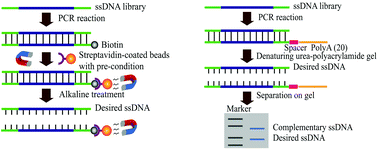Comparison of the methods for generating single-stranded DNA in SELEX
Abstract
The generation of single-stranded DNA (ssDNA) from double-stranded PCR products is an essential step in the selection of aptamers by systematic evolution of ligands by exponential enrichment (SELEX). Magnetic separation with streptavidin-coated beads is always the most commonly used method. Recently, two size separation methods derived from unequal primers with chemical or structural modification were designed in SELEX. In this report, we made a comparison between magnetic separation and the two size separation methods for generation of ssDNA from double-stranded PCR products. Our results showed that all the methods produced ssDNA of good purity. Compared to the magnetic separation, size separation derived from unequal primers with chemical modification achieved an almost equivalent recovery rate of ssDNA, whereas size separation derived from unequal primers with structural modification showed a lower recovery rate of ssDNA. Considering the low cost, size separation derived from unequal primers with chemical modification could be a satisfactory alternative to the classic magnetic separation for the generation of ssDNA in SELEX.


 Please wait while we load your content...
Please wait while we load your content...